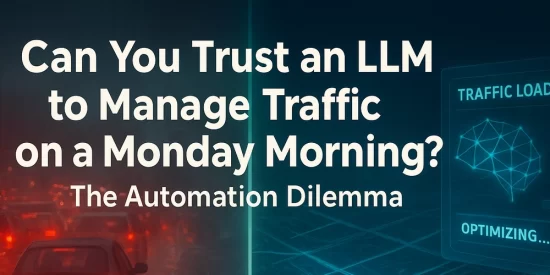The Automation Dilemma
It’s 8:45 AM on a Monday.
Rain clouds loom. Horns blare. The office chat is already buzzing with “stuck in traffic” messages.
Now imagine this — the entire city’s traffic lights, route suggestions, and emergency lane prioritizations… all controlled by an LLM.
No human traffic police. No manual overrides.
Just GPT-5’s cousin — running the roads.
Would you trust it?
🌪️ The Monday Morning Perfect Storm
Why Monday? Because that’s when the system faces the ultimate stress test.
- 🧠 23% higher cortisol levels: People are scientifically more stressed on Mondays.
- 🚗 62.54% of daily traffic happens between 6–9 AM.
- 💥 14.3% more accidents occur on Monday than Tuesday.
- ❤️ 19% spike in heart attacks, partly due to the infamous Monday blues.
So, if an AI can handle Monday morning chaos, it can handle anything.
🕹️ LLMs in the Traffic Control Room
You might think this is futuristic — it’s not.
LLMs are already managing traffic.
- Los Angeles: AI predictive systems cut delays by 20%.
- Singapore: AI video analytics sped up accident clearance by 30%.
- Dubai: Launched a fully autonomous Intelligent Traffic System — zero human input.
- Bengaluru: Over 165 intersections now use adaptive, AI-controlled signals.
How it works is mind-blowing:
The 4D Framework — Detect, Decide, Disseminate, Deploy.
- Detect: Real-time feeds from sensors, GPS, cameras.
- Decide: LLM reasoning determines who moves, when, and how fast.
- Disseminate: Communicates decisions via traffic lights, V2V, V2I signals.
- Deploy: Executes coordinated traffic control — in milliseconds.
These systems already achieve:
- ⚙️ 83% accuracy in conflict detection
- 🧩 0.84 F1-score in decision-making
- 📊 0.94+ ROUGE-L in priority assignment
But when safety meets automation — accuracy alone isn’t enough.
🤯 When AI Hallucinates at Rush Hour
Here’s the dark side: LLMs hallucinate.
In safety-critical systems, a 28.6% hallucination rate is catastrophic.
Imagine:
The AI misreads a sensor glitch as a traffic jam, reroutes 5,000 cars through a narrow residential street, and blocks an ambulance.
LLMs are prone to:
- Factual hallucinations: Inventing incidents that never happened.
- Logical hallucinations: Misattributing causes of congestion.
- Temporal hallucinations: Confusing timing of events.
- Contextual hallucinations: Misreading situational nuance.
And despite massive context windows (100K+ tokens), they still struggle with the “lost in the middle” problem — forgetting crucial details buried between data streams.
That’s not just inconvenient.
It’s dangerous.
⚖️ The Automation Paradox: Better AI, Worse Oversight
Here’s the irony:
The better automation gets, the less humans pay attention.
Eye-tracking studies show that operators look at AI indicators 40% less when systems are reliable.
That’s called automation-induced complacency — and it’s a silent threat.
When everything seems perfect, humans switch off.
Then when something goes wrong…
they react too late.
That’s the automation dilemma in a nutshell:
Smarter systems make dumber humans.
☁️ Edge Cases: When Monday Morning Breaks the Machine
AI is brilliant at the predictable.
It breaks at the weird.
Edge cases like:
- Sudden fog reducing sensor visibility
- Construction zones with temporary lanes
- A parade rerouting buses
- Pedestrians jaywalking near schools
- Accidents blocking multiple lanes
And then comes Monday — the ultimate edge case:
- 🧍♂️ Human stress spikes → erratic driving
- ⏰ Weekend-to-weekday transition → unusual traffic flow
- 😴 Sleep deprivation → delayed reactions
- 🧾 AI pattern mismatch → unseen data → confusion
LLMs trained on average patterns simply don’t know what to do when the city behaves abnormally — and on Mondays, it always does.
👀 Human Oversight: The Safety Net We Can’t Lose
Humans are still the final line of defense.
AI might decide when lights turn green, but humans decide why.
They bring:
- Context and moral judgment
- Pattern recognition in chaos
- Accountability when something goes wrong
That’s why even the EU AI Act mandates human oversight for “high-risk AI systems.”
And traffic management definitely qualifies.
But here’s the challenge:
- Oversight at this scale (billions of micro-decisions per hour) is nearly impossible.
- Fatigue sets in.
- Trust calibration breaks — people either overtrust or undertrust the system.
The goal? Calibrated trust.
Humans and machines sharing responsibility — transparently.
🧰 The Hybrid Solution: AI as the Assistant, Humans as the Directors
The safest approach isn’t full autonomy — it’s co-piloting.
🧩 Tiered Oversight Model
- Routine: AI runs things autonomously.
- Complex: AI recommends, humans approve.
- High-stakes: Humans decide with AI input.
- Emergencies: Instant human override.
🔒 Fail-Safe Systems
- Redundant AIs cross-check each other.
- Anomaly detection flags hallucinations.
- Manual override always one click away.
- “Graceful degradation” ensures fallback to standard signal patterns.
This hybrid model is already improving reliability by 12% and uptime by 10%.
🧠 The Future: Toward Trustworthy Traffic AI
Next-gen traffic LLMs will be much smarter.
They’ll feature:
- 🧮 Neuro-symbolic reasoning (combining logic with learning)
- 🔗 Retrieval-augmented generation for factual grounding
- 🧠 Hierarchical memory for long-context understanding
- 🤝 Multi-agent collaboration (one AI per subsystem)
- ⚡ Real-time adaptation from ongoing traffic data
When they can explain their reasoning, quantify uncertainty, and self-correct errors, only then can we talk about trust.
Until then — humans must remain in the loop.
🚨 The Verdict: Can We Trust an LLM on Monday Morning?
Let’s be honest:
Not yet.
Yes, AI can reduce congestion by 30%, clear accidents faster, and optimize signals city-wide.
But Monday morning isn’t just data — it’s emotion, stress, unpredictability, and chaos.
The automation dilemma reminds us:
The more we automate, the more vital human judgment becomes.
So, can an LLM manage Monday traffic?
Maybe.
But should it do it alone?
Absolutely not.
💬 What do you think — would you trust an AI to control your city’s roads on a Monday morning? Or do you still want a human watching the lights?
🧩 Written by Pratham Dabhane — exploring AI, automation, and the fine line between intelligence and intuition.



![how-to-scrape-youtube-using-python-[2025-guide]](https://prodsens.live/wp-content/uploads/2025/07/36894-how-to-scrape-youtube-using-python-2025-guide-380x250.webp)

